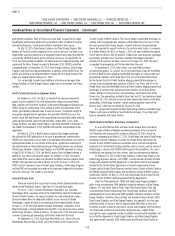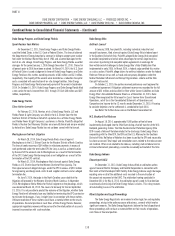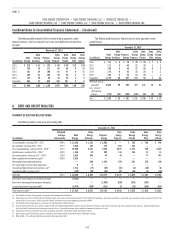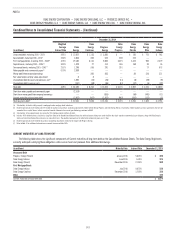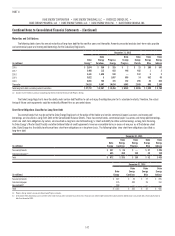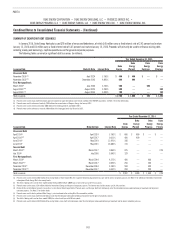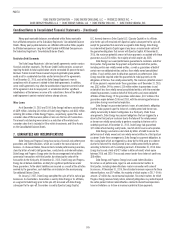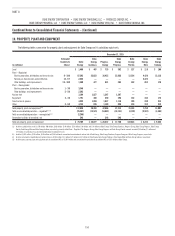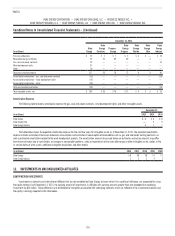Duke Energy 2015 Annual Report Download - page 164
Download and view the complete annual report
Please find page 164 of the 2015 Duke Energy annual report below. You can navigate through the pages in the report by either clicking on the pages listed below, or by using the keyword search tool below to find specific information within the annual report.
144
PART II
DUKE ENERGY CORPORATION • DUKE ENERGY CAROLINAS, LLC • PROGRESS ENERGY, INC. •
DUKE ENERGY PROGRESS, LLC • DUKE ENERGY FLORIDA, LLC • DUKE ENERGY OHIO, INC. • DUKE ENERGY INDIANA, INC.
Combined Notes to Consolidated Financial Statements – (Continued)
AVAILABLE CREDIT FACILITIES
Duke Energy has a Master Credit Facility with a capacity of $7.5 billion through January 2020. The Duke Energy Registrants, excluding Progress Energy (Parent), have
borrowing capacity under the Master Credit Facility up to specified sublimits for each borrower. Duke Energy has the unilateral ability at any time to increase or decrease
the borrowing sublimits of each borrower, subject to a maximum sublimit for each borrower. The amount available under the Master Credit Facility has been reduced to
backstop the issuances of commercial paper, certain letters of credit and variable-rate demand tax-exempt bonds that may be put to the Duke Energy Registrants at the
option of the holder and as security to meet obligations under the Plea Agreements. The table below includes the current borrowing sublimits and available capacity under
the Master Credit Facility.
December 31, 2015
(in millions)
Duke
Energy
Duke
Energy
(Parent)
Duke
Energy
Carolinas
Duke
Energy
Progress
Duke
Energy
Florida
Duke
Energy
Ohio
Duke
Energy
Indiana
Facility size(a) $ 7,500 $ 3,475 $ 800 $ 1,000 $ 1,200 $ 425 $ 600
Reduction to backstop issuances
Commercial paper(b) (3,138) (1,531) (300) (333) (709) (115) (150)
Outstanding letters of credit (72) (65) (4) (2) (1) — —
Tax-exempt bonds (116) — (35) — — — (81)
Coal ash set-aside(c) (500) — (250) (250) — — —
Available capacity $ 3,674 $ 1,879 $ 211 $ 415 $ 490 $ 310 $ 369
(a) Represents the sublimit of each borrower.
(b) Duke Energy issued $625 million of commercial paper and loaned the proceeds through the money pool to Duke Energy Carolinas, Duke Energy Progress, Duke Energy Ohio and Duke Energy Indiana. The balances are classified
as Long-Term Debt Payable to Affiliated Companies in the Consolidated Balance Sheets.
(c) On May 14, 2015, the United States District Court for the Eastern District of North Carolina approved the separate Plea Agreements entered into by Duke Energy Carolinas, Duke Energy Progress and DEBS, a wholly owned
subsidiary of Duke Energy, in connection with the investigation initiated by the USDOJ. Duke Energy Carolinas and Duke Energy Progress are required to each maintain $250 million of available capacity under the Master Credit
Facility as security to meet their obligations under the Plea Agreements, in addition to certain other conditions. See Note 5 for further details.
In connection with the Merger Agreement with Piedmont, Duke Energy
entered into a $4.9 billion senior unsecured bridge financing facility (Bridge
Facility) with Barclays Capital, Inc. (Barclays). The Bridge Facility, if drawn
upon, may be used (i) to fund the cash consideration for the transaction and
(ii) to pay certain fees and expenses in connection with the transaction. In
November 2015, Barclays syndicated its commitment under the Bridge Facility
to a broader group of lenders. Duke Energy intends to finance the transaction
with proceeds raised through the issuance of debt, equity, and other sources
and, therefore, does not expect to draw upon the Bridge Facility. See Note 2 for
further details.
On February 22, 2016, Duke Energy entered into a six-month term loan
facility (Term Loan) with commitments totaling $1 billion to provide additional
flexibility in managing short-term liquidity. The Term Loan can be drawn upon
in a single borrowing of up to $1 billion, which must occur no later than 45
calendar days following February 22, 2016. As of February 24, 2016, no
amounts have been drawn under the Term Loan. Amounts drawn under this
facility, if any, will be due on August 19, 2016. The terms and conditions of
this Term Loan are generally consistent with those governing the Master Credit
Facility discussed above.
OTHER DEBT MATTERS
Duke Energy Florida expects to issue $1.3 billion of securitization bonds
related to Crystal River Unit 3 in the first half of 2016. See Note 4 for additional
details.
In September 2013, Duke Energy filed a registration statement (Form S-3)
with the Securities and Exchange Commission (SEC). Under this Form S-3, which
is uncapped, the Duke Energy Registrants, excluding Progress Energy, may issue
debt and other securities in the future at amounts, prices and with terms to be
determined at the time of future offerings. The registration statement also allows
for the issuance of common stock by Duke Energy.
Duke Energy has an effective Form S-3 with the SEC to sell up to $3 billion
of variable denomination floating-rate demand notes, called PremierNotes. The
Form S-3 states that no more than $1.5 billion of the notes will be outstanding at
any particular time. The notes are offered on a continuous basis and bear interest
at a floating rate per annum determined by the Duke Energy PremierNotes
Committee, or its designee, on a weekly basis. The interest rate payable on notes
held by an investor may vary based on the principal amount of the investment.
The notes have no stated maturity date, are non-transferable and may be
redeemed in whole or in part by Duke Energy or at the investor’s option at any
time. The balance as of December 31, 2015 and 2014 was $1,121 million and
$968 million, respectively. The notes are short-term debt obligations of Duke
Energy and are reflected as Notes payable and commercial paper on Duke
Energy’s Consolidated Balance Sheets.
At December 31, 2015 and 2014, $767 million of debt issued by Duke
Energy Carolinas was guaranteed by Duke Energy.
Money Pool
The Subsidiary Registrants, excluding Progress Energy, receive support for
their short-term borrowing needs through participation with Duke Energy and
certain of its subsidiaries in a money pool arrangement. Under this arrangement,
those companies with short-term funds may provide short-term loans to
affiliates participating in this arrangement. The money pool is structured such
that the Subsidiary Registrants, excluding Progress Energy, separately manage
their cash needs and working capital requirements. Accordingly, there is no net
settlement of receivables and payables between money pool participants. Duke
Energy (Parent), may loan funds to its participating subsidiaries, but may not
borrow funds through the money pool. Accordingly, as the money pool activity
is between Duke Energy and its wholly owned subsidiaries, all money pool
balances are eliminated within Duke Energy’s Consolidated Balance Sheets.




